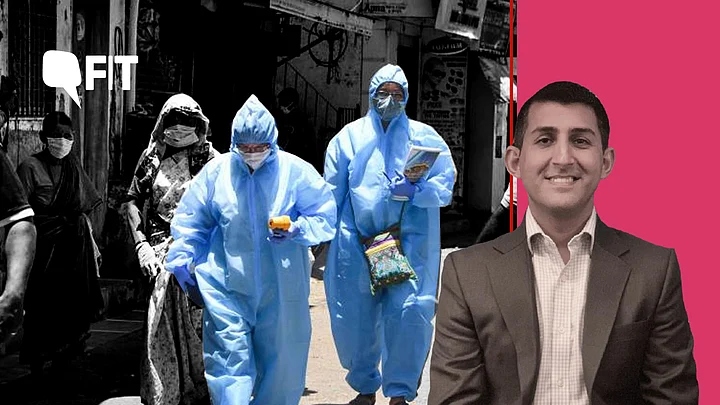In an agitated state he burst through; shouting loudly. Over the next few minutes the support staff and he engaged, in a conversation, about why he was sent to the hospital. He questioned the very purpose of my visit and medical advice. I was hoping for gratitude, but my second fever screening camp ended in a heated moment. Let’s rewind ninety minutes.
The setting this week was different. I was driven to an urban colony close to the council office. The van entered a dirt field, which contained a football goal (minus a net) and what looked like an unused cricket pitch in its centre. At one end stood a line of sheds, one of which we converted into the makeshift medical centre. The team was different but the roles remained the same. Registration counter, vitals check (body temperature, heart rate and blood oxygen level) and then a conversation with me about their symptoms with medications dispensed, if I felt it was needed.
Over the two hours we received seventy five patients, fifty of which were screened, forty of whom had symptoms. The process today was different; the message sent to the local residents was to come to see the doctor if they were suffering from symptoms.
It seems that there has been a subtle shift in the approach -- one which will play out to lead to the scene I experienced.
The symptomology remained the same as last week, flu like experiences with body ache, sweats and head congestion. What was markedly different this time was that there were significantly less complaints of a cough and many more presentations of loss of smell and taste (anosmia). All in all, of the six patients I thought to refer to the nearest testing centre - patients whom I suspected, four had complaints of smell and taste loss.
One such patient was the thirty year old young man who would return to the camp later - rejected and agitated. He had experienced seven days of fever, headaches and nasal congestion. He had a slight cough and was gradually feeling ‘weaker’ each day. He had a fever of 99.7 degrees Celsius and an elevated heart rate at 110 beats per minute. He had lost his sense of smell about four days ago and complained that his food, when he would feel interested to eat, had a metallic taste. I handed over two days worth of analgesia, decongestants and some vitamin C tablets. I was unable to prescribe any paracetamol (to control the fever) as these tablets had been discontinued in our usual medicine kit. The rationale being to no longer mask the fever (through self medication) and therefore encourage symptomatic individuals to come forward for screening. It prevented relief, which was one of my main objectives, but I accepted the protocol.
The young man asked me why I was not giving him anything for his fever, to which I explained, in as polite and sensitive a way I could, that the doctors at the testing centre would see him, conduct a thorough examination, screen him for the virus and give him the appropriate medicines, if it was necessary. This is where the process started to break down.
When Process Hinders Help
The young man, on my recommendation, immediately made his way to the local screening centre only to have apparently been dismissed by the medical team and sent away. Understandably distraught, around ninety minutes later, he returned to the medical camp, just as we were packing up our things. This is where we return to the beginning of this story. It seems as if the local hospital was inundated and found him unsuitable for formal testing; he therefore did not receive any medication. He found himself caught in a conflict between the field screening and the testing centre.
The ideal process would see me treat any minor community complaints, not mask any patients harbouring a fever and drive a funnel of referrals towards the formal testing centres.
There they should be thoroughly questioned, examined, screened and tested. Where upon, should they test positive, be provided with treatment, contact tracing advice and isolation. It sounds perfectly fair and I was ready to play my part. The challenge arose due to the increase in cases which the city is now experiencing and the practicalities of dealing with ever increasing numbers of in-patients, walk in complaints and those being referred to by the network of fever screening camps. No fault at all of the patient, but the one who gets caught in the middle and ends up suffering. Of course there was nothing that I could say to him when he returned, and empathically I listened and wished I could do more for him. I understood his frustration. The city is caught in a surge; we are all trying to help.
Two hours later, as the midday sun was high in the sky, thankfully a gentle breeze made its way across the otherwise still ground to provide some relief to me - under the layers of PPE which I was wearing. I felt thirsty and removed my mask to drink some water. I looked out on the field and wondered when the next time the young boys and girls may be able to pick up their cricket bat or football and play freely again.
Join me next week as we continue our journey ‘From the Frontlines’; in an episode where I will face the negative fallout, on patient care, caused by the stigma and fear created in society.
You can read the first blog in the series From the Frontlines, here.
(Dr Marcus Ranney is a business professional in healthcare and technology. He has volunteered to help with COVID-19 pandemic in Mumbai)
(At The Quint, we question everything. Play an active role in shaping our journalism by becoming a member today.)
